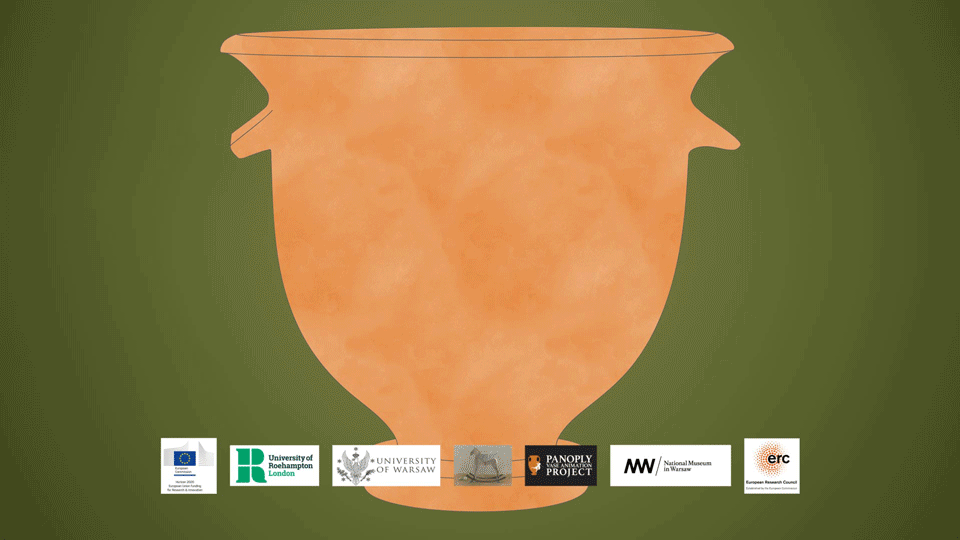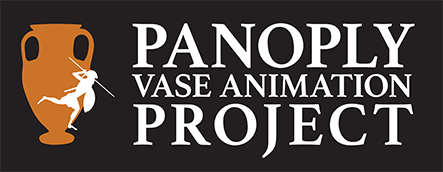Pottery was the super stuff of the ancient world! Without plastic and with little access to glass, a waterproof material that could be made into any shape was fantastic for all your storage, carrying, and serving needs!
Pottery is created from clay mixed with water. The clay itself occurs naturally in the ground. Potters refine the clay, shape it, and heat it carefully at high temperatures. That causes it to fix hard and makes it waterproof. Each patch of clay has its own chemical make-up that makes it look a particular colour and behave its own way. That chemical signature (such as more or less iron particles) can be identified with a microscope and sometimes it is clear enough to see with the eye. This analysis informs archaeologists about where a vase was made.
'Pots' and 'vases' are essentially the same thing. Ancient Greek pots are more often called 'vases' because talking and writing about them is a legacy of art history, a field in which skilfully produced vessels are known as 'vases'.
Shapes
Between the 8th-3rd centuries BCE skilled potters were at work creating pottery for their own communities and for export. They created their pots according to a range of widely-used shapes. Let's look at some of the main shapes:
Amphora
An amphora is two-handled container vase with many uses. They range from the very small to the very large. An amphora would have a lid, although their lids have often been broken or lost over time. The handles and lid made the amphora perfect for carrying goods and storing them; wine, oil, honey, grain, olives – they could be kept or carried in an amphora. Very large amphora might even be partially submerged in the ground to keep the goods inside cool (as in Heracles and the Erymanthian Boar). The name comes from 'amphi' – on both sides, and 'phero' – carry ('amphorae' in the plural).
Amphorae come in different shapes. Rough, undecorated ones with pointed bottoms were used as basic vessels for transporting goods. Finer, decorated ones were in use in the home. These can be essentially divided into 'belly amphora', with the handles on a single piece pot which is wide in the middle and narrower at the top and bottom.
The 'neck amphora' has a similar narrow-wide-narrow shape, but a separate section is added to extend the neck of the vase upwards. Some of these are 'ovoid', with a rounded shoulder (these are also called 'Tyrrhenian amphorae'), while the standard neck amphora has a broad shoulder at the top part of the 'wide' section, from which the neck stands out.
A bit like an amphora is the 'pelike'. These are also two-handled storage vessels, although these have a rounder bottom rather than the tapered finish.
Amphora animations: Heracles and the Erymanthian Boar; Clash of the Dicers; Heracles; Well-Wishers; Plant Food (pelike).

Hydria
Like amphorae, the hydria (plural 'hydriai') is a common shape. They have a rounded body and a neck which either sits atop a curved upper body or between wide shoulders. The hydria's name comes from its function – they were used for carrying water ('hydor'). That function means that a hydria has three handles: horizontal handles on either side for carrying, and a vertical one on the back for pouring. The third handle means that decoration is focused on the front and sometimes on the shoulder, not on the front and back as an amphora would have it. Hydriai are frequently quite large as it was more efficient to bring as much water as a person could carry in one go between the water source and the home. We know from vase scenes that this was typically a woman's task. A hydria could also be used for other purposes, such as collecting ballots or containing a deceased person's ashes. A hydria with rounded shoulders is sometimes called a 'kalpis'.
Hydria animations: Sappho 44; Iris – Rainbow Goddess; Libation
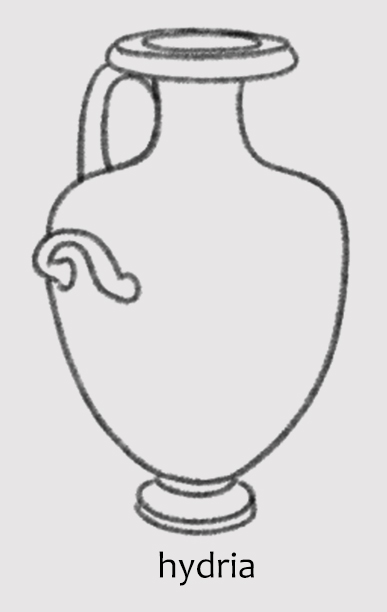
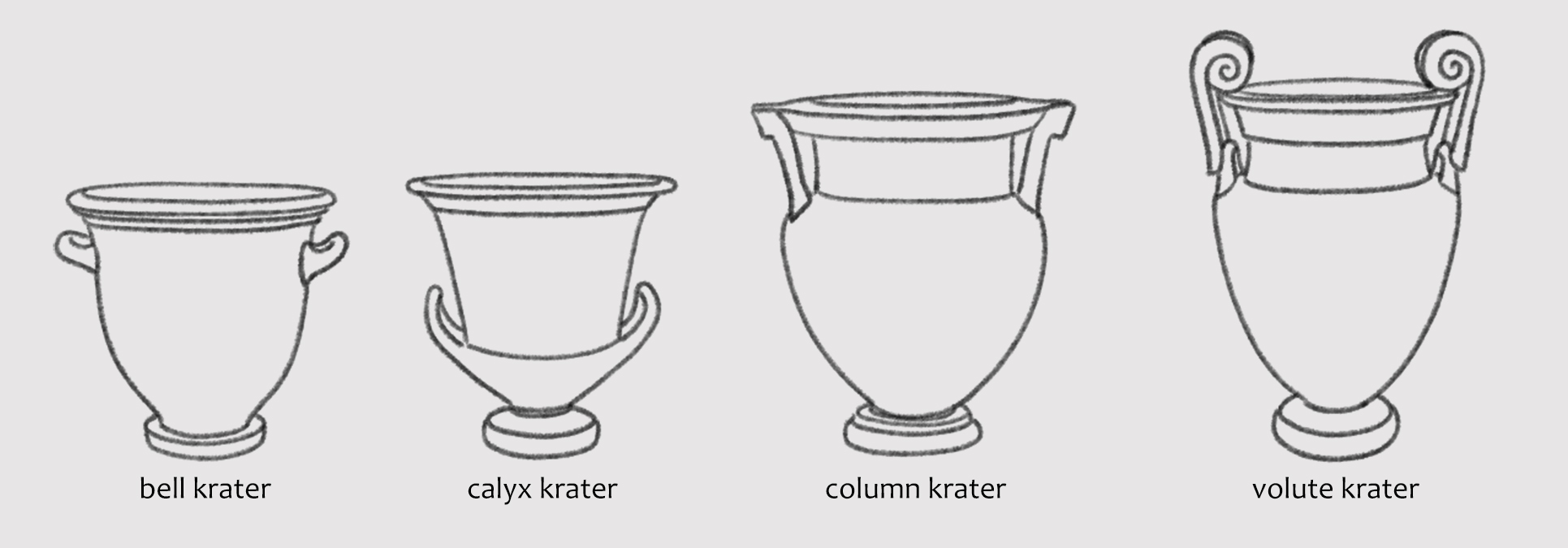
Krater
The krater has a wide body, a wide open top, and two handles. They were used at symposiums for mixing water and wine together. They could also be used as grave markers or containers for a dead person's ashes. There are four main types of krater, distinguished by the style of the handles or the shape of the body.
The calyx krater has handles very low down on the vase. The way they curl upwards looks like the calyx of a flower.
The column krater has column-shaped handles which reach from the top of the shoulder up to the wide neck of the vase.
The volute krater also has handles reaching from the shoulder to the top of the wide neck, however these handles are more elaborate, curled to look like the curling volutes on Ionic columns. Volute kraters are frequently bigger than the other kinds of kraters.
Bell kraters have a more rounded, bell-shaped body, with two horizontal handles half way up the sides.
Krater animations: Dionysus; Bad Karma, The Procession; Love of Honour.
Lekythos
A lekythos (plural 'lekythoi) is a tall, slim vessel with one handle and a narrow neck with a mouth-like top. These vases were used for perfumed oil or household oil; the narrow neck and mouth helped control the flow of oil. Older lekythoi often have a more oval body than the ones from the 5th century onwards, which have a straighter side and a shoulder.
Lekythoi were frequently used in funerary contexts, with the oil left as an offering at or in a grave. Some lekythoi have an inner chamber which reduced the amount of oil it took to fill them, meaning that a token gesture of oil could be left. 'White-ground' lekythoi were created by covering the whole body of the vase in white slip. This allowed for extraordinary clarity in the images added on to the white surface.
Lekythos animations: Pandora; Sirens.
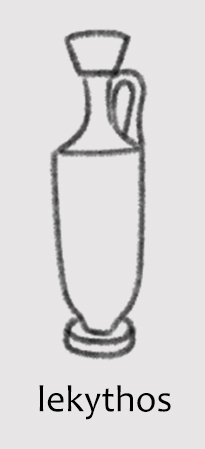
Jug
Jugs are distinguished by their pour-friendly mouths. They have one handle. Oinochoe ('wine-pourer') refers to jugs of several shapes; their name indicates their function as a serving vessel for wine. You will also find reference to chous (plural 'choes'), a roundish jug with a trefoil – or 'three-spouted' mouth. These are particularly associated with the Anthesteria festival, a celebration of new wine also associated with the dead. Miniature choes often feature scenes of children's lives; they were given to children and have been found in significant numbers in children's graves.
Jug animations: The Rattle; Dance Off.
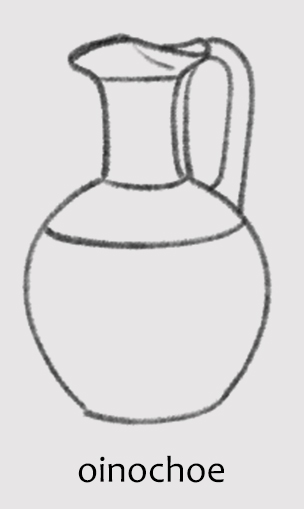
Cup
The Greeks elaborate symposium culture ensured that cups come in a variety of forms. The kylix (plural 'kylikes') is the most commonly found wine cup. It's often shallow, and is very wide by modern cup standards. The kylix has two handles and its bowl is typically connected to a foot by a stem, although some are stemless. The feet sometimes come in novelty shapes.
The skyphos (plural 'skyphoi') is closer to a modern mug than a kylix is – it has a deep bowl with a smaller diameter and two small handles.
The kantharos (plural 'kantharoi') is a deep wine cup. This style is made distinctive by its flamboyant high handles.
The rhyton (plural 'rhyta') has the form of a one-handled drinking horn. In some cases liquid could be poured right through the rhyton, exiting from a small hole at the bottom to create a bubbly effect in the wine. In other rhyta the bottom is closed so that the horn shape vessel can serve as a cup. Some rhyta are rather elaborate, formed in the shape of animal heads or imaginative scenes. The upper cup section would be wheel-made; the head would be formed in a mold.
Cup animations: Symposium (kylix); Medusa (kylix); Runners, The Cheat, Hermes' Favour (skyphos fragment); Amazon (skyphos); Pelops (skyphos).

Lekanis
A lekanis (plural 'lekanides') is a broad shallow bowl with two horizontal handles, a foot, and – typically - a lid. Marriage scenes can often be seen on a lekanis, although that's not the only subject matter found – the one which features on this site has athletics and fighting scenes. These could be used for serving food or for keeping bits and bobs in.
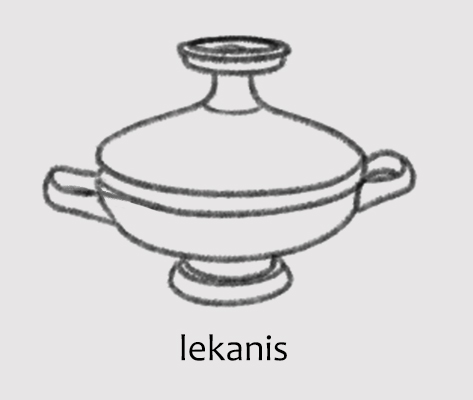
Dinos
A dinos (plural 'dinoi') is a deep, rounded bowl without handles or a foot. Owing to their shape, they were frequently mounted on a stand to prevent spillage. These are also known as 'lebes'.
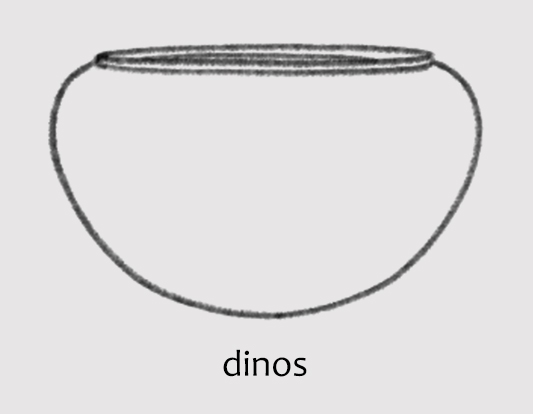
Psykter
The psykter is a handle-less vessel made in a striking mushroom shape. They were used for cooling wine, either by placing a psykter of cold water, snow or ice into a krater of wine, or a psykter of wine into a cold-filled krater. Having the wine in the psykter is perhaps more likely as it would cool more quickly that way round, but nobody knows for sure. This shape was not used for long – from the late-6th to the mid-5th centuries BCE. They deserve a special mention here because these vases enabled the Greeks to experiment with a form of vase animation. The decoration on the psykter would appear to bob about as it sat in the liquid in the krater and especially when wine was ladled out into a cup. This created the impression that the figures were moving. Greek potters adapted to this and decorated them with a continuous scene going all the way around rather than creating a front and back panel. Sometimes they used images of sea creatures, such as this famous one of soldiers riding dolphins – probably an image related to a drama.
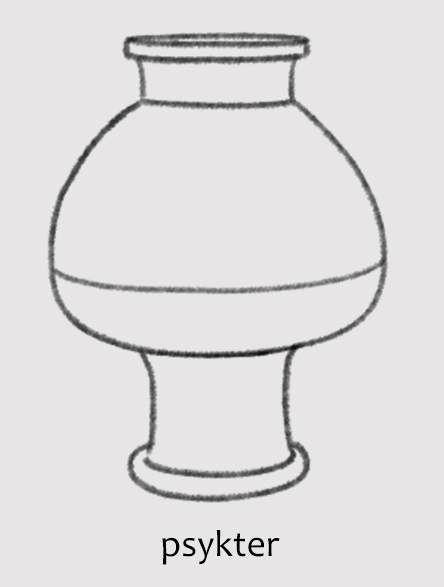

Words and Phrases
Some Greek vases have words on them. This began in the workshops of Corinth in the 7th century BCE, with potters adding labels to some of their figures. Athenian figures picked this up and started adding labels in the 6th century, until they became less common as the 5th century wore on.
Words can be written left to right or right to left (called 'retrograde’).
Words painted on with slip are called ‘dipinti’.
Words scratched into the surface are called ‘graffiti’.
Common terms:
Names: painters frequently add a person's name beside them to indicate who has been depicted (See Clash of the Dicers and Sappho Fragment 44).
Kalos: names also appear on 'kalos vases'. In this case the name is a reference to a person in the real world. 'Kalos / kale' means 'beautiful / handsome / lovely'. Adding someone's name and 'kalos' was a popular way of offering a tribute to a fashionable and handsome youth. The person commissioning the vase would have to ask for it specially. More than two hundred such names are preserved.
Maker and decorators' marks: e.g. Amasis mepoiesen, Amasis potted me / made me. Sometimes there is a distinction: x egraphsen, y mepoiesen = x painted me, y made me. Sometimes the same person did both jobs: e.g. Exekias egraphsenkapoesme = Exekias painted and potted me. Notice how these phrases make the pot speak! Some maker's marks give extra information about the person: e.g. x son of y; or x the slave; y the Lydian. Maker and decorator signatures begin to disappear in 4th century.
Prize marks: A special shape of amphora was created for prize vases given out at the Athenian festivals. These are usually marked: ‘ton Athenethen athlon’ 'I am one of the prizes from Athens'.
Gibberish? Some words don't appear to mean anything and have just been added as extra decoration. Occasionally, however, the meaning of words once thought meaningless are discovered.
Names again: In the 5th century the Athenians developed a political practice called 'ostracism'. Male citizens had an opportunity to vote for someone to be expelled from the city for ten years. They voted by graffitiing the person's name onto an ostracon – a piece of broken vase – hence the name 'ostracism'. Many of these have been discovered, featuring some of the most prominent figures of the classical period. Occasionally they have a mean message on them too - so harsh!
Vases are an amazing resource for researching all sorts of aspect of ancient culture.
Read some of our interviews to find out more:
Curating Pots with Prof. Amy Smith.
Archaeology and the potter's wheel with Dr Jill Hilditch.
Constructing the African with Najee Olya.
Ancient theatre with Dr Rosie Wyles.
Military leaders and sacred space with Panoply's Dr Sonya Nevin.
Death, funerals, and the afterlife with Dr Bridget Martin.
Symposiums with Dr Thomas Mannack.
Symposiums with Prof. Sir John Boardman.
Ships and piracy with Dr Philip de Souza.
Electra, ancient and modern with Dr Anastasia Bakogianni.
Magic, play, and games with Prof. Véronique Dasen.
Ancient music with Prof. Conrad Steinmann.
Ancient Greek warfare with Dr Fernando Eccheverría.
Horses with Dr Tom Donaghy.
